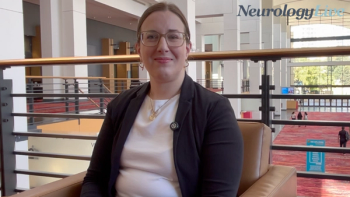
Searching for a Biomarker in MS: Neurofilament Light Chain
The medical director of clinical development at Biogen spoke about the current use of the biomarker and the steps being taken clinically validate it.
Bernd Kieseier, MD
Physicians and other clinicians treating multiple sclerosis (MS) have been searching for a way to identify a disease-specific biomarker for more than 3 decades to no avail. Although, in recent years, a non-specific, but potentially incredibly valuable biomarker has been pinpointed: neurofilament light.
While it has yet to be clinically validated, several studies have assessed the biomarker’s use and have shown its ability to reflect damage to axons caused by disease or trauma. Despite the non-specificity for MS, this has opened up a plethora of options for neurofilament’s use in exploring the effects of disease-modifying therapies in both MS and other neurodegenerative diseases.
Bernd Kieseier, MD, the medical director of clinical development at Biogen, has worked extensively to help get a more widely used assay in use for clinical practice. With so-called homebrew kits being utilized by physicians to use the otherwise affordable assay, there has not been much uniformity. But Kieseier and his colleagues seek to change that.
To provide some insight into the current use of the biomarker and the steps that are being taken to validate it clinically, Kieseier spoke with NeurologyLive in an interview.
NeurologyLive: How is neurofilament light currently being used, and how is it being clinically validated?
Bernd Kieseier, MD: The trouble is that physicians use things how they actually come at hand. Theoretically, yes, you can physically measure neurofilament at various labs today. One way is measuring it with their own homebrewed assay, and they’re actually commercially available and ready. The trouble is the hardware. You need quite expensive equipment to use those assays—you can buy [the assay] for $50. A good example for that you can neutralize antibodies against interferon—that was a hot topic in the MS space like 10 years ago—everyone was doing what they were going to do, but there are discrepancies from assay to assay. This time, we want to make them right.
What’s happening now within the communities, within academic sites as well as the biotech industry and pharma, we’re doing a round of tests to make sure that using the same sample, using the same assay, around the globe can generate the same values. That’s kind of this validation process for us to figure out if we can standardize an assay like that. At the same time, as Biogen announced at ECTRIMS, the currently available assays—they’re good for signs but not for clinical practice where you need large-scale assays.
We are actually working together with Siemens Healthineers. They have huge platforms for routine lab value assessment, and so, you can easily implement neurofilament as one parameter amongst all the others you measure every day in clinical routine. We hope and believe that we can actually drive, together with Siemens, the development of an assay that is equally sensitive but much more applicable in a clinical routine. Then, if we reach the point, hopefully, next year, where we can say that “OK, this is doable,” then it can actually roll out into clinical practice and could be done on all these machines out there.
What are the potential capabilities of neurofilament light as a biomarker?
I personally think we can use it as a marker for disease activity. You could see whether a patient is under good control, so if you have a low level of neurofilament, this means that based on this assay there is no evidence of inflammation—this is what we want. It would give you confidence in the treatment you were choosing, you could use it as a monitoring tool, and it’s still to be defined whether you have to do it over 3 months or every 6 months, but you can track your patient with how well the disease is under control. It could also replace, to some extent, potentially, MRI imaging so it’s easier for the patient. You just do a blood draw and you don’t have to go to the MRI machine, you don’t need gadolinium. It could be a good marker for disease activity—more work has to be done.
In some studies, it could predict the clinical course or clinical trajectory of the individual patient, so you can see that this patient is at a higher risk to be disabled 5 years down the road, and for that reason, you could actually change your treatment paradigm and be much more aggressive. That’s also very interesting and appealing information, but for that latter piece, we need more work to be done to corroborate this finding. But these are at least the 2 components we’re looking at from the MS perspective.
Neurofilament is non-specific to MS. Is that a concern?
I don’t see a concern because why should I believe that I need an MS-specific marker? I’m not looking for something that is MS specific, I’m looking for an indicator of axonal damage. The brain is being damaged. Yes, if I measure it, I should rule out that the patient that I’m just investigating didn’t play soccer the night before and didn’t hit his head. Yes, those things can actually spoil those results. And yes, you need good healthy controls, you need good controls with comorbidities to rule out if other diseases could actually kind of create background noise when you use these. But look, at the end of the day, I’m not looking for something that’s specifically happening in MS because neuronal damage happens in a huge number of different diseases.
To some extent, I’m happy that this is the case because this creates much more interest in the entire community to use this value, and you can use it as a general marker for brain damage. And yes, there are enough studies out there looking at brain trauma and the value of neurofilament as an indicator for recovery, and in other neurodegenerative diseases we’re looking into neurofilament as well. It’s not going to be an MS-specific marker, but if I look to the amount or degree of damage at this point happening in the brain, and we know that the patient is suffering from inflammatory disease, that’s all I want to know.
Looking for an MS-specific marker—we’ve been doing this for the last 30 years. It’s not leading anywhere. The key for looking for information we want to acquire is something that indicates brain damage. Something I want to note—even if you use an MRI, there is no specific MRI for MS. Even if you use the best criteria for an MS MRI, you still have only a specificity of 85% or so. Anything that’s happening in terms of damage can cause similar lesions. I’m confident that, in the right context, this biomarker gives us the right information, but yes, you have to be aware that this is not specific.
Is there anything you’d like to add?
The data that we presented at ECTRIMS highlight the potential of this marker, and I think in the near future we’re going to have this round robin, which will tell us how easy or how difficult it is to drive an assay across the globe and then hopefully we will know to which extent we can use this as a broader assay on a more commercially available platform, which is in the end what we really need.
Transcript edited for clarity.
Newsletter
Keep your finger on the pulse of neurology—subscribe to NeurologyLive for expert interviews, new data, and breakthrough treatment updates.









































